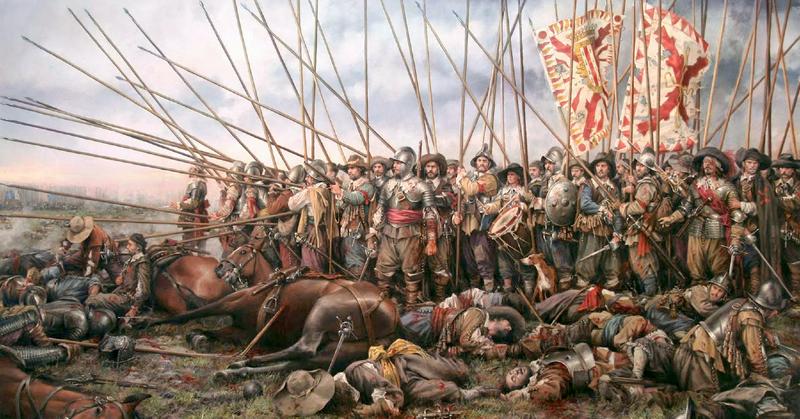Thirty Years' War: History, Events, Timeline, And Death Count
By | October 24, 2020

The Thirty Years' War is one of the least-discussed European conflicts despite the fact that its estimated death toll is higher than the American Civil War and Napoleonic Wars combined. That's partially because the war was 30 years long and frankly confusing, with many of the issues facing the people of Europe being compounded by a sudden mini ice age that devastated agriculture. It is nonetheless an important war, as it was arguably the last true religious war of European history.
Centuries after Martin Luther nailed the Ninety-five Theses to a church door, the Protestant Reformation was still going strong, but by the turn of the 17th century, most people had figured out how to live in peace. Even the Hapsburg-run Holy Roman Empire managed to rule areas of Protestant majority with relatively little conflict until 1618, when the new emperor, Ferdinand II, rescinded the Letter of Majesty which promised religious freedom to Protestants and instead claimed all of the Holy Roman Empire as Catholic land.

All Those Defenestrations
As you can imagine, the Protestants didn't like this much. Bohemia, a Protestant stronghold, retaliated with epic style with the Defenestration of Prague, although technically, it was the Second Defenestration of Prague (or super technically, the third Defenestration of Prague) because history can be tricky sometimes.
What in the Holy Roman Empire is a defenestration? To put it simply, it means to get so angry at someone that you literally throw them out a window, although it's most useful in the modern era as an S.A.T. vocabulary word. Back then, it was the only way to describe the actions of the Bohemians on May 23, 1618, when revolters shoved Ferdinand II's local representatives out of a window, where they fell an excruciating 70 feet.
Amazingly, they survived. According to the Catholic Church, it was by the grace of the intervention of angelic beings, but the Protestants insisted they'd fallen into a large pile of manure. Either way, the violence of the Defenestration of Prague made its way back to the ears of Ferdinand II, and the Thirty Years' War was on.

It Was So Long, You Guys
The first phase of the war was short lived, as the Bohemian people possessed little political or military power. They reached out to several powerful nations, but no one was quite willing enough to put their full effort behind the cause.
The Bohemians elected a mid-ranking leader named Frederick V, who attempted to score some level of success but despite great efforts, like the Battle of White Mountain, ultimately lost and found himself banished from the entire Holy Roman Empire by 1623. In retaliation, the Holy Roman Empire seized land and again instated Catholic rule above all. You'd think that would end it, right? Just another story of a religious minority rising up but ultimately going nowhere.
Not so fast. The Protestant King of Denmark, who was so Christian that his name was Christian IV, became worried that the neighboring states of the House of Hapsburg would soon fall to Catholic rule as well. He joined up with England and Scotland to take down the Holy Roman Empire but lost a huge number of their soldiers in the Battle of Lutter on August 27, 1626. Soon after, the Edict of Restitution was passed, and the Catholics again consumed the lands of central Europe. That was definitely the end, right?
Knock, knock. Who's there? It's the Swedish coming in to once again fight the Holy Roman Empire over religious freedom, led by the legendary Gustavus Adolphus, A.K.A. "the Father of Modern Warfare," who scored win after win for the Protestants for once. The Swedish couldn't bankroll the war alone, however, so they turned to the French for help.

The Final Phase
France, famously a Catholic nation, backed the Swedish despite their religious differences in an effort to weaken the House of Hamburg, who bordered France on both sides and had held too threatening of a power for much too long. France saw a chance to level the playing field, so they took it, turning the tide of European war from religious to political and social in nature for the rest of history.
Once France joined the fray, the final phase of the Thirty Years' War was on. It quickly became the bloodiest, as a major power had begun fighting another major power. Both sides participated in cruelty upon cruelty to rectify their power, but the Holy Roman Empire was responsible for some truly horrific things, most notably the Sack of Magdeburg, in which the population of one of the largest cities of Germany at the time was reduced from 25,000 to a mere 5,000 as murder and violent sexual assault ran rampant while the city burned.
Finally, after millions of deaths, the continent called it quits out of sheer exhaustion, seeing no end in sight or worthwhile resources to be gained. The Protestant Reformation finally came to an official close at the end of the Thirty Years' War in 1648, when the Peace of Westphalia was signed, resulting in a weakening of the Holy Roman Empire and the French conquer of greater land. This leads many to believe the French won the Thirty Years' War, but after decades of horror and millions upon millions dead, it's hard to call anyone a winner. Maybe this was one of those moments in history when we should have just laughed at a few guys falling into a pile of dung and called it a day.

